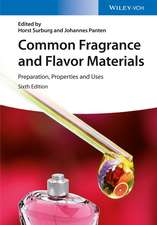Fruit Processing
Autor D. Arthey, P.R. Ashursten Limba Engleză Hardback – 30 dec 1995
| Toate formatele și edițiile | Preț | Express |
|---|---|---|
| Paperback (1) | 998.90 lei 43-57 zile | |
| Springer Us – 18 sep 2012 | 998.90 lei 43-57 zile | |
| Hardback (1) | 949.23 lei 43-57 zile | |
| Springer Us – 30 dec 1995 | 949.23 lei 43-57 zile |
Preț: 949.23 lei
Preț vechi: 1157.60 lei
-18% Nou
Puncte Express: 1424
Preț estimativ în valută:
181.63€ • 190.15$ • 150.29£
181.63€ • 190.15$ • 150.29£
Carte tipărită la comandă
Livrare economică 07-21 aprilie
Preluare comenzi: 021 569.72.76
Specificații
ISBN-13: 9780751400397
ISBN-10: 0751400394
Pagini: 248
Ilustrații: XIII, 248 p.
Dimensiuni: 155 x 235 x 16 mm
Greutate: 0.55 kg
Ediția:1996
Editura: Springer Us
Colecția Springer
Locul publicării:New York, NY, United States
ISBN-10: 0751400394
Pagini: 248
Ilustrații: XIII, 248 p.
Dimensiuni: 155 x 235 x 16 mm
Greutate: 0.55 kg
Ediția:1996
Editura: Springer Us
Colecția Springer
Locul publicării:New York, NY, United States
Public țintă
ResearchDescriere
Fruit and fruit products, in all their many varieties and variations, are major world commodities and part of the economic life blood of many countries, particularly in the developing world. The perception of the healthy nature of fruit is a major reason for its increased consumption in the developed world, and many consumers today find a wider selection of fruit varieties, available at all times of the year, than ever before. This volume, however, is not so much concerned with fresh fruit as those principal areas of processing to which it may be subjected. Fruit processing arose as a means of utilising a short-lived product and preserving its essential nutritional qualities as far as possible. A chapter on the nutritional aspects of fruit is included in this work to reflect the importance of this topic to most consumers. After a general introduction, the chapter on fruit storage is the only contribution which deals with a process from which fruit emerges in essentially the same physical condition. Beyond that the book sets out to cover most of the major areas in which fruit may be processed into forms which bear varying semblances to the original raw material.
Cuprins
1. Introduction to fruit processing.- 1.1 Processing on a global scale.- 1.2 Factors influencing processing.- 1.3 Fruit types for processing.- 1.3.1 Pome fruits.- 1.3.2 Citrus fruits.- 1.3.3 Stone fruits.- 1.3.4 Soft fruits.- 1.4 Controlling factors in the ripening of fruit.- 1.4.1 Respiration climacteric.- 1.4.2 Ethylene production.- 1.5 Biosynthesis of flavours.- 1.5.1 Analytical data.- 1.5.2 Taste and aroma.- 1.5.3 Flavour formation.- 1.5.4 Physiological and biochemical aspects.- 1.6 Factors influencing fruit quality and crop yield.- 1.6.1 Fruit variety.- 1.6.2 External factors affecting fruit quality.- 1.7 Flavour characteristics.- 1.8 The global market: threats and opportunities.- 1.9 Fruit processing.- 2. Fruit and human nutrition.- 2.1 Introduction.- 2.2 Composition of fruits.- 2.3 The importance of fruit in the human diet.- 2.4 Changes in nutritive value during processing.- 3. Storage, ripening and handling of fruit.- 3.1 Maturing and ripening.- 3.1.1 Climacteric behaviour.- 3.1.2 Ethylene.- 3.1.3 Maturity standards.- 3.2 Temperature and respiration.- 3.2.1 Field heat removal by pre-cooling.- 3.2.2 Cool storage of fruit.- 3.2.3 General requirements of a coolroom.- 3.2.4 Mixed storage.- 3.3 Storage atmospheres.- 3.3.1 Controlled atmosphere (CA) technology.- 3.3.2 Atmosphere regeneration.- 3.3.3 Modified atmosphere technology.- 3.4 Maintaining quality.- 3.4.1 Disease.- 3.4.2 Disorders.- 3.4.3 Injury.- 4. Production of non-fermented fruit products.- 4.1 Introduction.- 4.2 Fruit quality.- 4.3 Temperate fruit juices.- 4.3.1 Orange juice.- 4.3.2 Citrus juices.- 4.3.3 Apple juice.- 4.3.4 Pear juice.- 4.3.5 Stone fruit juices.- 4.3.6 Berry juices.- 4.4 Tropical fruit juices.- 4.4.1 Pineapple juice.- 4.4.2 Papaya purée.- 4.4.3 Mango pulp.- 4.4.4 Passionfruit juice.- 4.4.5 Guava pulp.- 4.5 Clarification of fruit juices.- 4.6 Methods of preservation.- 4.6.1 Thermal treatment of the juice.- 4.6.2 Canning.- 4.6.3 Aseptic processing.- 4.6.4 Bottling.- 4.6.5 Chemical preservatives.- 4.6.6 Freezing.- 4.6.7 Filtration sterilization.- 4.7 Concentration of fruit juice.- 4.7.1 Essence recovery.- 4.7.2 Concentration.- 4.8 Products derived from fruit juice.- 4.8.1 Fruit juice drink.- 4.8.2 Fruit nectars.- 4.8.3 Carbonated beverages.- 4.9 Adulteration of fruit juice.- 5. Cider, perry, fruit wines and other alcoholic fruit beverages.- 5.1 Introduction.- 5.2 Cider.- 5.2.1 A brief history.- 5.2.2 Cider and culinary apples.- 5.2.3 Fermentation of cider.- 5.2.4 Special types of cider.- 5.2.5 The microbiology of apple juice and cider.- 5.2.6 The chemistry of cider.- 5.3 Perry (poire).- 5.4 Fruit wines.- 5.4.1 Fruits used in fruit wine manufacture.- 5.4.2 Processing of the fruit.- 5.4.3 Fermentation of fruit wines.- 5.4.4 Fruit pulp fermentations.- 5.4.5 Alcohol-fortified wines.- 5.4.6 Sparkling (carbonated) fruit wines.- 5.5 Fruit spirits and liqueurs.- 5.5.1 Fruit spirits (sic fruit brandies).- 5.5.2 Apéritifs and liqueurs.- 5.6 Miscellany.- 6. Production of thermally processed and frozen fruit.- 6.1 Introduction.- 6.2 Raw materials.- 6.3 Canning of fruit.- 6.3.1 Cannery hygiene.- 6.3.2 Factory reception.- 6.3.3 Peeling.- 6.3.4 Blanching.- 6.3.5 Choice of cans.- 6.3.6 Filling.- 6.3.7 Syrup.- 6.3.8 Cut out.- 6.3.9 Closing.- 6.3.10 Exhausting.- 6.3.11 Can vacuum.- 6.3.12 Processing.- 6.3.13 Finished pack pH values.- 6.4 Varities of fruit.- 6.4.1 Apples.- 6.4.2 Apricots.- 6.4.3 Bilberries.- 6.4.4 Blackberries.- 6.4.5 Black currants.- 6.4.6 Cherries.- 6.4.7 Gooseberries.- 6.4.8 Grapefruit.- 6.4.9 Fruit salad.- 6.4.10 Fruit cocktail.- 6.4.11 Fruit pie fillings.- 6.4.12 Loganberries.- 6.4.13 Oranges.- 6.4.14 Peaches.- 6.4.15 Pears.- 6.4.16 Pineapple.- 6.4.17 Plums and damsons.- 6.4.18 Prunes.- 6.4.19 Raspberries.- 6.4.20 Rhubarb.- 6.4.21 Strawberries.- 6.5 Bottling.- 6.6 Freezing.- 6.6.1 Freezing methods.- 6.6.2 Storage.- 6.6.3 Packaging.- 6.7 Aseptic packaging.- 6.7.1 Sterilisation/pasteurization.- 6.7.2 Packaging.- 7. The manufacture of preserves, flavourings and dried fruits.- 7.1 Preserves.- 7.1.1 Ingredients.- 7.1.2 Fruit for jam manufacture.- 7.1.3 Other ingredients.- 7.1.4 Product types and recipes.- 7.1.5 Methods of manufacture.- 7.2 Fruits preserved by sugar: glacé fruits.- 7.3 Fruits preserved by drying.- 7.3.1 Dried vine fruit production.- 7.3.2 Dried tree fruit production.- 7.4 Flavourings from fruits.- 7.5 Tomato purée.- 8. The by-products of fruit processing.- 8.1 Introduction.- 8.2 By-products of the citrus industry.- 8.2.1 Citrus premium pulp (juice cells).- 8.2.2 Products prepared from peel and rag.- 8.2.3 Citrus oils.- 8.2.4 Comminuted juices.- 8.2.5 Dried citrus peel.- 8.3 Natural colour extraction from fruit waste.- 8.3.1 Extraction of colour from citrus peels.- 8.3.2 Extraction of colour from grapes.- 8.4 Apple waste treatment.- 8.5 Production of pectin.- 8.5.1 Characterisation of pectin and pectolytic enzymes in plants.- 8.5.2 Pectin enzymes in plants used for production of pectin.- 8.5.3 Commercial pectins and their production.- 8.5.4 Different types of pectin and their application.- 8.5.5 Application of pectin in medicine and nutrition.- 9. Water supplies, effluent disposal and other environmental considerations.- 9.1 Introduction.- 9.2 Water sourcing.- 9.3 Primary treatment.- 9.3.1 Screening.- 9.3.2 Colour removal.- 9.3.3 Adjustment of pH.- 9.3.4 Filtration.- 9.3.5 Carbon adsorption.- 9.3.6 Primary disinfection.- 9.4 Secondary treatment.- 9.4.1 Boiler feedwater.- 9.4.2 Cooling water.- 9.4.3 Water for bottle-washing.- 9.4.4 Water for fruit dressing.- 9.4.5 Water for process use.- 9.4.6 Water for special applications.- 9.4.7 Cleaning-in-place (CIP).- 9.5 Effluent planning.- 9.5.1 Segregation.- 9.5.2 Effluent transfer.- 9.5.3 Effluent reception.- 9.5.4 Treatment objectives.- 9.6 Effluent characterization.- 9.6.1 Suspended solids.- 9.6.2 Oxygen demand.- 9.6.3 Other parameters.- 9.6.4 Effluent monitoring.- 9.7 Effluent treatment.- 9.7.1 Solids removal.- 9.7.2 pH adjustment.- 9.7.3 Biological oxygen demand (BOD).- 9.8 Forms of biological treatment.- 9.8.1 The activated sludge process.- 9.8.2 Percolating ‘filters’.- 9.8.3 High-rate filtration.- 9.8.4 Mechanical contacting.- 9.9 Tertiary treatment.- 9.9.1 Filtration.- 9.9.2 Solids removal and disposal.- 9.9.3 Recovery and re-use options.- 9.10 Environmental auditing.- 9.10.1 Baseline assessment.- 9.10.2 Period review.- 9.10.3 Quality and environmental standards.














